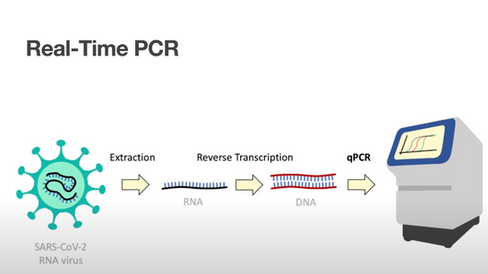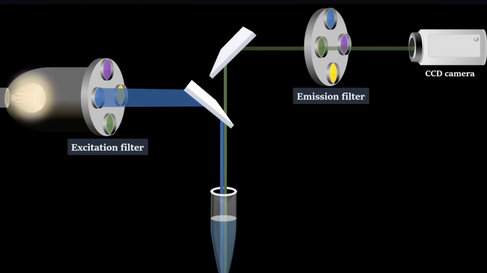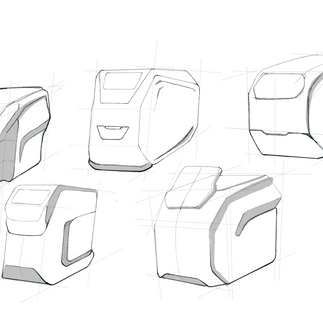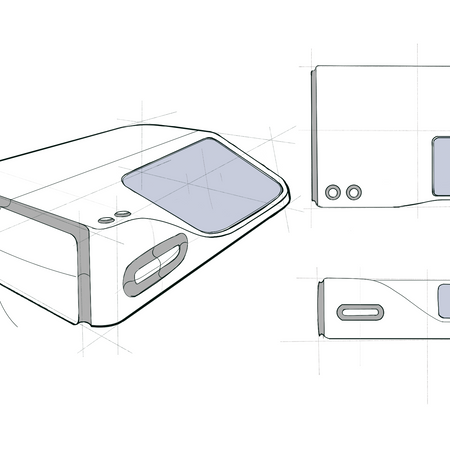
REAL-TIME PCR Design
This project focuses on the design of a real-time PCR (Polymerase Chain Reaction) testing device
Bachelor Thesis | University of Art, 2022
Introduction
This project presents the design of a compact, real-time PCR testing device capable of detecting bacterial and viral pathogens, including SARS-CoV-2. With its vertical form and minimal footprint, the device is specifically designed for use in confined or mobile medical settings, making advanced diagnostics more accessible.
Drawing inspiration from the aesthetics of modern consumer electronics, the interface and disc tray are crafted to provide a clean, intuitive, and user-friendly experience. By integrating a microfluidic system and lab-on-chip technology, the device simplifies the testing process while maintaining accuracy and reliability.
The design aims to not only streamline the physical interaction but also reduce the complexity typically associated with lab testing, making it more efficient for healthcare professionals and more adaptable to diverse clinical environments.
Research
The foundation of this project lies in understanding the Polymerase Chain Reaction (PCR)—a widely used molecular biology technique that enables scientists to create millions or even billions of copies of a specific DNA segment. This amplification process allows for the detailed analysis of extremely small DNA samples, making it essential in diagnostics, genetics, and biomedical research.
Building on this, the focus turns to Real-Time PCR (RT-PCR), a more advanced method that not only amplifies DNA but also allows for the real-time detection of specific genetic material. Originally developed using radioactive markers, this technique has evolved to use fluorescent dyes to monitor DNA amplification as it happens. Unlike conventional PCR, which only provides results at the end of the process, real-time RT-PCR enables scientists and healthcare professionals to observe the data live, significantly reducing response times in diagnostics.
This research phase was critical to understanding the functional and technological requirements of the device, informing decisions about layout, user flow, and the integration of lab-on-chip and microfluidic systems to enhance usability and speed in real-world healthcare settings.
Working Prototype
The functional prototype of the Real-Time PCR device was developed to test both the structural and technical viability of the system. The image above illustrates the internal engineering layout, showcasing the integration of microcontrollers, thermal management systems, and interface ports.
Built using a custom-fabricated metal body, the prototype includes essential USB, serial, and Ethernet ports, allowing for potential data transfer, firmware updates, and remote diagnostics. A vertical structural configuration was chosen to conserve space while maintaining efficient airflow and easy access to components.
Key technical elements include:
Microcontroller integration for system control and data processing
Heatsink and fan system for temperature regulation during amplification cycles
Accessible I/O ports for real-time data communication
Modular wiring and power routing, designed for rapid iteration and testing
This prototype represents a critical step toward a fully functional lab-grade diagnostic tool. It not only demonstrates the technical feasibility of the design but also provides a strong foundation for future refinements in form factor, component layout, and user interaction.



Engineering Optimization & Internal Organization
Following the development of the initial working prototype, the next phase focused on internal component optimization. The goal was to reorganize and compact the internal hardware, reducing the device’s footprint without compromising functionality or accessibility.
Using CAD modeling and exploded views, I restructured the layout of all major elements—including the thermal module, microfluidic interface, fan and cooling units, power supply, and control boards. This redesign allowed for:
Improved airflow and thermal efficiency
Streamlined wiring paths for better maintenance and safety
Optimized spatial layering to reduce height and width
Simplified assembly and future scalability
The result is a more compact, efficient, and professional-grade housing that supports the demands of real-time PCR testing while making the device more suitable for clinical and mobile environments. This phase was crucial in aligning engineering functionality with industrial design clarity.

Design & Form Study
As part of the development process, a Form Study Prototype was created to explore the physical presence and ergonomic interaction of the PCR device. Unlike the functional prototype, this model focused purely on scale, shape, proportion, and visual balance—allowing for a deeper investigation into how the device would be perceived and used in real clinical environments.
This phase was essential for:
Testing the overall size and footprint of the device
Evaluating ergonomic considerations, such as screen angle, user access, and loading mechanisms
Refining visual language, ensuring the design communicates cleanliness, clarity, and ease of use
The aesthetic direction drew from modern consumer electronics, favoring minimal surfaces, clean lines, and intuitive touchpoints to reduce visual complexity and align with professional medical environments.
The form study provided valuable feedback that informed both the final shell design and the user interaction zones, ensuring a device that looks as smart as it functions.
Color Palette
The selected color palette was carefully chosen to reflect the professional, clean, and sterile environment of medical and laboratory settings. Neutral tones such as white, soft gray, and matte black dominate the exterior to convey precision, trust, and clarity, while minimizing visual noise.
These colors not only align with industry standards but also enhance the readability of the interface and the perceived cleanliness of the device. Accent elements were kept minimal and subtle to maintain focus on the user experience and the product’s functionality.
This restrained palette supports the design’s goal of clear communication, reduced stress in clinical environments, and visual integration into existing healthcare spaces.

Ergonomics
Designing for Safe, Intuitive, and Controlled Interaction
In this project, ergonomics played a crucial role in shaping a device that is safe, accessible, and user-friendly, especially in high-stress environments like medical labs.
Preventing Unwanted Activation
The control system was designed to minimize accidental use by:
Using resistant or recessed buttons for sensitive operations
Avoiding overly sensitive keys that could be triggered unintentionally
Placing non-essential controls away from primary interaction zones
Ensuring all actions—like powering on—require intentional input
Emergency Controls
In emergencies, speed and clarity are critical. Therefore:
Large, red emergency buttons were incorporated for quick identification
Positioned away from regular-use buttons to reduce confusion
Controls are kept visible and accessible within the user’s natural field of view
User Positioning & Comfort
Control zones were laid out based on natural human movement to reduce physical strain and error:
The primary interaction area (15–45 cm from the user’s torso at elbow height) houses all frequent-use controls
Secondary controls are placed up to 60 cm away, within a comfortable reach
If a user must sit or stand for operation, the design accommodates proper posture with no need for bending or twisting
User Research & Field Insights
To ensure the design meets real-world needs, extensive user research was conducted through laboratory visits, interviews, and collaborative discussions with professionals in the field of biotechnology. These interactions provided key insights into workflow, pain points, and user priorities—informing both the functionality and ergonomics of the device.
Supported by the Strategic Center of Convergent Technologies, the project has been shaped by think-tank meetings with experts in biotech and diagnostics. This feedback helped define the interface clarity, operational ease, and environmental adaptability of the device.

Ideation Process


Final Model
Final Design
The final model of the real-time PCR device reflects a careful balance between precision engineering, user experience, and visual clarity. Compact and modern, the design emphasizes both functionality and emotional comfort, with soft contours and a clean interface that reduce stress in clinical settings.
Key features include:
Intuitive touchscreen interface, angled for visibility and ease of use
Compact form factor, optimized to fit in crowded labs or mobile units
Dedicated test cartridge slot with soft internal lighting to guide interaction
Simplified user flow, allowing fast setup, clear status feedback, and minimal training
Material and color choices were guided by medical design principles—emphasizing hygiene, trust, and simplicity. The result is a future-ready diagnostic device that feels at home in professional healthcare environments while maintaining a human-centered design language.




References & Research Sources
This project was supported by extensive research into real-time PCR technology, medical device design, prototyping methods, and ergonomic standards. Key sources include:
Online Resources
Print Sources (Persian)
لسکو جیم. (۱۳۹۷). طراحی صنعتی: مواد و فرایندهای تولید. سازمان مطالعه و تدوین کتب علوم انسانی دانشگاهها (سمت). ترجمه: کاوه مقدم.
اشرفی حمیدرضا، پولادخان علیرضا. (۱۳۹۳). مواد هوشمند و کاربرد آن در رشتههای مختلف علوم و مهندسی. نشر نوآور.
انجمن بینالمللی ارگونومی. (۱۳۹۲). نکات بازبینی ارگونومی. مؤسسه کار و تأمین اجتماعی. ترجمه: مهدی کاظمی.
Project Gallery





















































